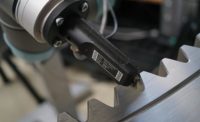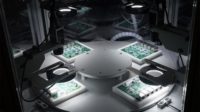Industrial endoscopes once included only rigid borescopes and flexible fiberscopes using coherent optical fiber bundles. In the early 2000s, videoscopes came into play, taking advantage of available technologies and CCD chips. Today, videoscopes are pushing the physical limitations of capturing images from small diameter insertion tubes while offering user-focused options, such as touch-screen interfaces and ergonomic designs. Videoscopes have come a long way in the past decade, and operators can look forward to exciting new trends.
Impressive Images
Videoscopes are imaging tools that are frequently used for remote visual inspections. From aviation to power generation, a clear image is crucial to understanding the condition of equipment and making critical decisions. Even though there is a demand for high-quality images, there is some confusion and misunderstanding about how a great image is produced. Some believe that the higher the pixel count, the better the image. The reality is that it’s not that simple. The images on a videoscope’s screen are the product of the imaging chip, optical lensing system, light source, and corrections for aberrations. Traditional light sources, such as halogen lamps and macro and micro LEDs are starting to give way to intensely bright laser light sources. Modern videoscopes have lighting systems and image processors that intelligently minimize glare and optical distortions. As carefully balanced imaging systems push the limits of image resolution in videoscopes, users can expect to see better, more brilliant inspection images. As new videoscope software automatically corrects for more problems, the operator can spend less time adjusting settings to obtain the best image.
Improved Measurement Capabilities
Certain applications require a videoscope that can make accurate measurements. Tried-and-true stereo measurement provides depth, area, distance, and point-to-line measurements. The involved technique of one-to-one matching, where an optical tip adaptor is paired with a single scope on a specialized jig, has expanded the capabilities of stereo measurement and increased precision. Previously, stereo measurement required operators to position the distal end of the insertion tube very close to the crack or defect. Now, stereo measurement can be performed from twice the distance as was possible with previous-generation videoscopes, covering an inspection area four times larger. This means that a 1.5-inch flaw can be measured from one inch away. Operators can expect to spend less time navigating and positioning the distal end for a stereo measurement.
Features that Support Evaluation
Features that support an inspector’s work are available to help get answers. Simple videoscopes that only record images are popular, but mid-range and high-end videoscopes have clever features that aid operators in evaluating flaws. Operators can compare a saved image taken from a previous inspection to a live image on a split screen. The saved image can even be overlaid on a live image at the desired opacity to help inspectors recognize changes, such as a new nick or the lengthening of a crack. These image comparison features enable the operator to quickly evaluate the condition of equipment in the field. Text and symbol annotations on images, notes, and voice memos are all features designed to increase the efficiency of an inspector’s workflow. Prompts for filing and naming the saved images help operators stay organized after the inspection. Images and notes can be streamlined into customizable reports, drastically cutting down on the time needed to create a report and reducing the amount of time an inspector spends recounting observations.
Form Factor
The design and form factor of videoscopes are increasingly focused on operator comfort. Videoscopes are used in a wide range of environments from the gear boxes in wind turbines to underground pipelines. To accommodate these diverse and sometimes challenging workspaces, videoscopes are manufactured in numerous shapes and sizes. Some are lightweight and designed for single-handed operation for maximum portability. When portability is crucial, videoscopes tend to have smaller screens and compact bodies with simpler operating systems. Some are built to military standards and are fully outfitted with interchangeable insertion tubes. Videoscopes are available with touch screens, remote controls, and detachable monitors. Some videoscopes can easily mount to a tabletop or workstation. In addition, a growing trend is integrating the carrying case so that it can be used as a stand for the videoscope. Whatever the inspection environment, there is a videoscope designed to best suit the operator, rather than having the operator struggle to accommodate the equipment.
Connectivity
Inspection images must often be reviewed by a team member offsite. As demand for connectivity is growing, videoscopes offer solutions, such as integrated Wi-Fi, for image sharing and even live streaming. While equipment is being inspected in the field, a team member in the office or at another field location can have a virtual presence by viewing and providing feedback on the live inspection with a desktop, tablet, or smartphone. Features that support collaboration and teamwork are growing as more organizations want to quickly share inspections for review.
Videoscopes have proven to be important inspection tools in many industries. Over the last 10 years, videoscope technology has evolved to deliver better images, more useful tools to help inspectors, and better ergonomics. As the needs of inspectors continue to change over time, videoscopes will continue to evolve to meet the changing needs of industry.



